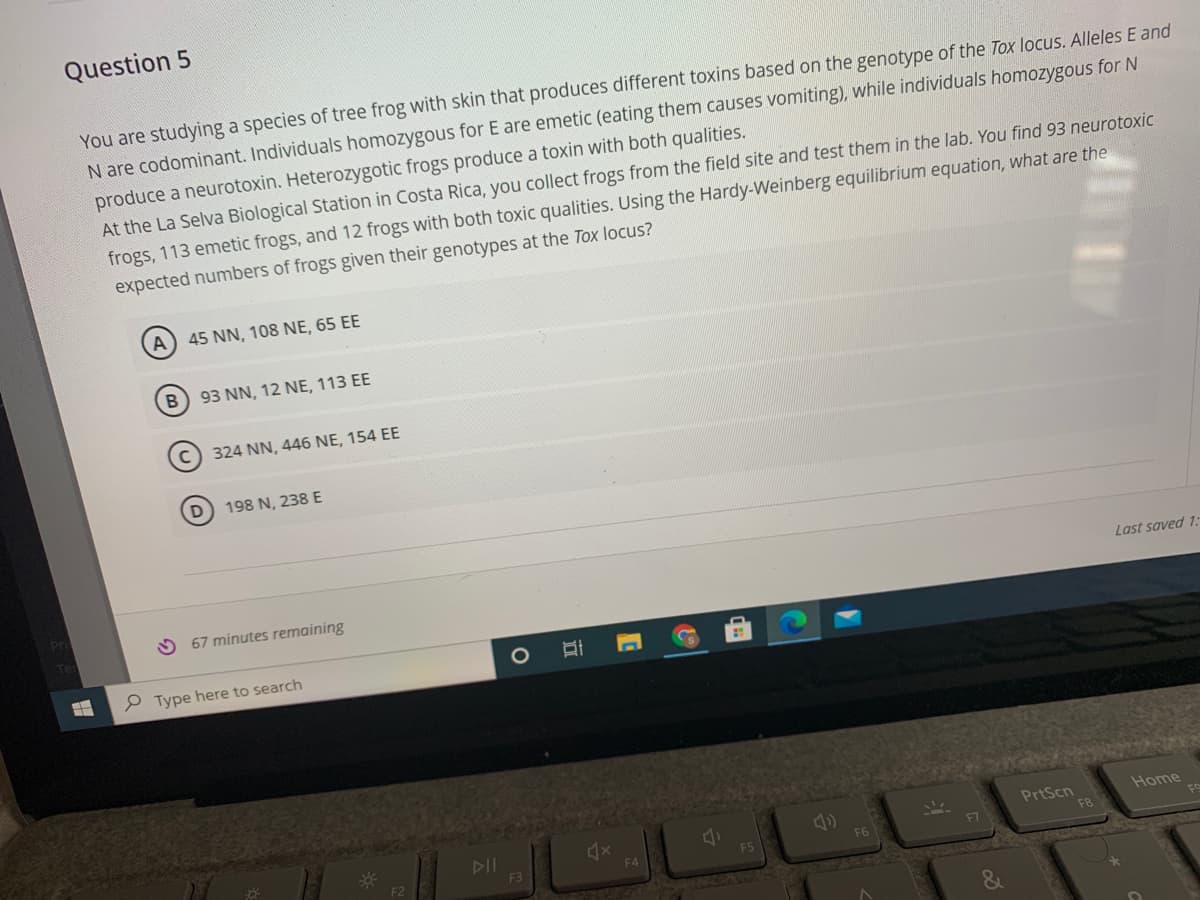Question 5 You are studying a species of tree frog with skin that produces different toxins based on the genotype of the Tox locus. Alleles E and N are codominant. Individuals homozygous for E are emetic (eating them causes vomiting), while individuals homozygous for N produce a neurotoxin. Heterozygotic frogs produce a toxin with both qualities. At the La Selva Biological Station in Costa Rica, you collect frogs from the field site and test them in the lab. You find 93 neurotoxic frogs, 113 emetic frogs, and 12 frogs with both toxic qualities. Using the Hardy-Weinberg equilibrium equation, what are the expected numbers of frogs given their genotypes at the Tox locus? A) 45 NN, 108 NE, 65 EE B 93 NN, 12 NE, 113 EE C) 324 NN, 446 NE, 154 EE 198 N, 238 E Last saved
Question 5 You are studying a species of tree frog with skin that produces different toxins based on the genotype of the Tox locus. Alleles E and N are codominant. Individuals homozygous for E are emetic (eating them causes vomiting), while individuals homozygous for N produce a neurotoxin. Heterozygotic frogs produce a toxin with both qualities. At the La Selva Biological Station in Costa Rica, you collect frogs from the field site and test them in the lab. You find 93 neurotoxic frogs, 113 emetic frogs, and 12 frogs with both toxic qualities. Using the Hardy-Weinberg equilibrium equation, what are the expected numbers of frogs given their genotypes at the Tox locus? A) 45 NN, 108 NE, 65 EE B 93 NN, 12 NE, 113 EE C) 324 NN, 446 NE, 154 EE 198 N, 238 E Last saved
Case Studies In Health Information Management
3rd Edition
ISBN:9781337676908
Author:SCHNERING
Publisher:SCHNERING
Chapter6: Leadership
Section: Chapter Questions
Problem 6.44.5C
Related questions
Topic Video
Question

Transcribed Image Text:Question 5
You are studying a species of tree frog with skin that produces different toxins based on the genotype of the Tox locuS. Alleles E and
N are codominant. Individuals homozygous for E are emetic (eating them causes vomiting), while individuals homozygous for N
produce a neurotoxin. Heterozygotic frogs produce a toxin with both qualities.
At the La Selva Biological Station in Costa Rica, you collect frogs from the field site and test them in the lab. You find 93 neurotoxic
frogs, 113 emetic frogs, and 12 frogs with both toxic qualities. Using the Hardy-Weinberg equilibrium equation, what are the
expected numbers of frogs given their genotypes at the Tox locus?
45 NN, 108 NE, 65 EE
B 93 NN, 12 NE, 113 EE
324 NN, 446 NE, 154 EE
D) 198 N, 238 E
Last saved 1.
67 minutes remaining
P Type here to search
Home
DII
PrtScn
F8
F6
F7
F3
F4
F5
Expert Solution
This question has been solved!
Explore an expertly crafted, step-by-step solution for a thorough understanding of key concepts.
This is a popular solution!
Trending now
This is a popular solution!
Step by step
Solved in 2 steps

Knowledge Booster
Learn more about
Need a deep-dive on the concept behind this application? Look no further. Learn more about this topic, biology and related others by exploring similar questions and additional content below.Recommended textbooks for you

Case Studies In Health Information Management
Biology
ISBN:
9781337676908
Author:
SCHNERING
Publisher:
Cengage

Case Studies In Health Information Management
Biology
ISBN:
9781337676908
Author:
SCHNERING
Publisher:
Cengage